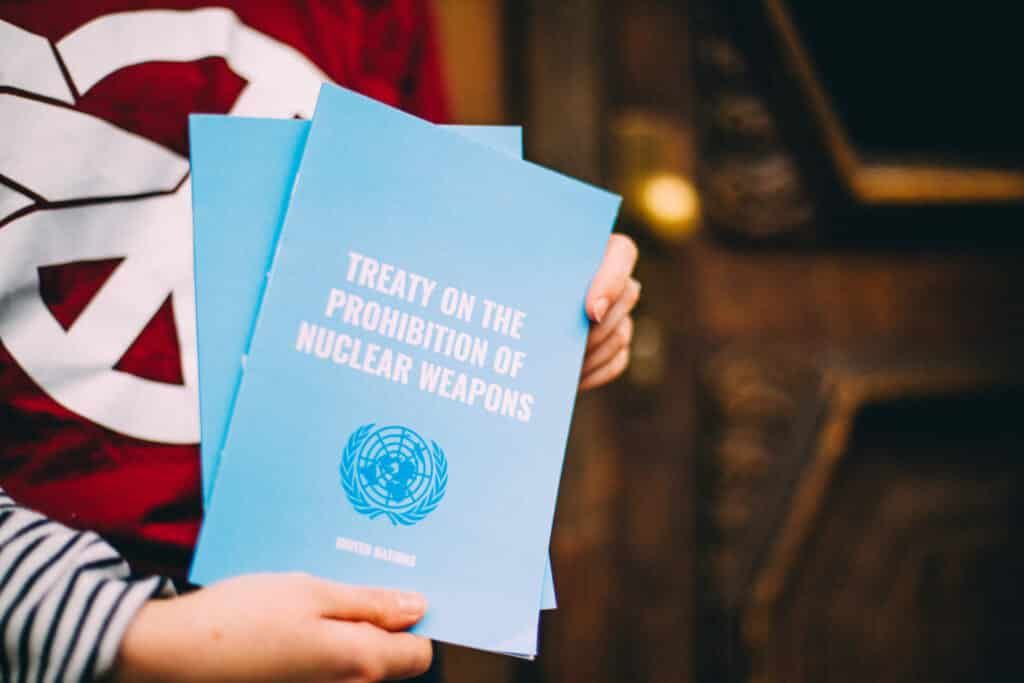What’s next for the nuclear ban treaty?
By Ruth Rohde | July 19, 2022
 UN Treaty on the Prohibition of Nuclear Weapons entered into force in January 2021. Photo by Aude Catimel for ICAN
UN Treaty on the Prohibition of Nuclear Weapons entered into force in January 2021. Photo by Aude Catimel for ICAN
It is a remarkable summer for arms control conferences. In August, the states parties to the Nuclear Non-Proliferation Treaty will meet in New York—two years, one pandemic, and one invasion after the meeting was originally scheduled. In late June, the states parties to the Treaty on the Prohibition of Nuclear Weapons (TPNW) met in Vienna—five years after 122 nations voted to adopt the first international treaty to comprehensively ban nuclear weapons.
In the midst of a war in Ukraine that has brought not only Russian threats of nuclear weapons use but also new worries about nuclear proliferation, and at a time of ongoing modernization of nuclear arsenals, states parties attending the ban treaty meeting last month committed to “not rest until the last state has joined the treaty, the last warhead has been dismantled and destroyed and nuclear weapons have been totally eliminated from the Earth.”
But these countries did more than reiterate their opposition to nuclear weapons: They also adopted a concrete action plan for implementing the treaty. A closer look at the plan reveals the next steps toward nuclear disarmament.
A condemnation of nuclear threats. In the Vienna Declaration issued at the end of the meeting, states unequivocally condemned “any and all” nuclear threats and declared they were “alarmed and dismayed by threats to use nuclear weapons and increasingly strident nuclear rhetoric.” While the declaration does not mention any countries by name, the message emanating from the meeting spurred a response from the Russian Ministry of Foreign Affairs, which denied making any such threats.
But the Vienna Declaration is more than a condemnation. In line with other humanitarian disarmament treaties, the declaration emphasizes the “moral and ethical imperatives” that led to the creation of the nuclear ban treaty, including the threat posed by nuclear weapons to the existence of humanity.
The declaration thus sets out a different vision of security than, for example, the recently published NATO Strategic Concept. The strategic concept uses language like strengthening NATO’s “deterrence and defence posture” and promotes an “appropriate mix” of deterrence and defense capabilities, including nuclear. Instead of a clear commitment to disarmament as a contributor to global security, NATO countries are looking to create the “security environment for a world without nuclear weapons.” This sends the message that nuclear weapons are a key to security, whereas the ban treaty’s message is that nuclear weapons are a threat to everyone’s security.
Membership in NATO and support for the ban treaty are not mutually exclusive. Some allies of nuclear-armed states have signaled an openness to the treaty or support for it. Of the current and future NATO countries, Finland, Sweden, Norway, Germany, the Netherlands, and Belgium all observed the Vienna meeting. While making it clear they do not plan to immediately join the treaty, some stressed areas of possible cooperation. Germany and Norway addressed a focus of the treaty: the humanitarian consequences of nuclear weapons. Neutral Switzerland also emphasized victim assistance and environmental remediation as a potential avenue of engagement. The civil society coordinator of the meeting, the International Campaign to Abolish Nuclear Weapons (ICAN), has already presented proposals to these states about how they could engage in these areas.
To-do list for TPNW states. Beyond a strong political declaration, states also adopted the first action plan to advance disarmament in over a decade. The 2010 Nuclear Non-Proliferation Treaty (NPT) Action Plan remains largely unimplemented. The 50-point TPNW action plan identifies facilitators, milestones, and deadlines.
The Vienna Action Plan is structured around six sections: universalization of the treaty, steps toward the total elimination of nuclear weapons, measures to address the human and environmental effects of nuclear weapons, institutionalizing scientific and technical advice, the relationship between the nuclear ban treaty and the nuclear disarmament and nonproliferation regime, and other matters essential for achieving the treaty’s goals—including principles for inclusivity and cooperation, such as implementing the gender provisions of the ban treaty.
The plan is remarkable because it sets out achievable actions for each section. States also committed to setting up various working groups, national contact people, and focal points.
The treaty breaks new ground in nuclear disarmament action plans for its inclusivity and its gender- and age-sensitive approach, recognizing that women and girls are disproportionately harmed by nuclear weapons use. The action plan also envisions including civil society at every step of the way in the implementation of the treaty—especially ICAN, the International Committee of the Red Cross and, most important, affected communities, particularly Indigenous peoples. This mirrors action plans adopted in the context of other humanitarian disarmament projects, such as the landmine and cluster munition bans.
Following the advice of a group of researchers, the Vienna meeting adopted deadlines for the destruction of nuclear weapons within 10 years, and within 90 days for the removal of nuclear weapons from a hosting state’s territory—with possibilities for extension, once a nuclear-armed or hosting state joins the treaty. States also agreed to establish a scientific advisory group to help with the implementation of the treaty.
Cooperation beyond the countries supporting the ban treaty. Treaty members have embraced the existing disarmament architecture, especially the NPT, which in the ban treaty and the Vienna Declaration is called the “cornerstone of the disarmament and nonproliferation regime.” States also committed to supporting the Comprehensive Nuclear Test Ban Treaty. Furthermore, member states agreed to cooperate with affected states currently not party to the treaty.
What is next? Several working groups have been formed: one to press for universalization of the treaty, chaired by Malaysia and South Africa (itself of course a former nuclear armed state); one focused on victim assistance and environmental remediation, chaired by Kazakhstan and Kiribati (both states affected by nuclear testing); and one working on steps toward the total elimination of nuclear weapons, including the designation of a competent international authority for verification, co-chaired by Mexico and New Zealand. A Gender Focal Point will be established under the leadership of Chile.
The next meeting of states parties is scheduled for November 27, 2023, in New York.
In just a couple of weeks, the outcomes of the nuclear ban treaty meeting will likely be raised at the NPT review conference. While a rebuke of Russia’s nuclear rhetoric is unlikely to garner consensus, NPT states should look to the Vienna Declaration and Action Plan for inspiration on condemning nuclear threats. The conference should also reinforce the findings of its 2010 final document, which expressed “deep concern” over the “catastrophic humanitarian consequences” that would result from the use of nuclear weapons.
The NPT conference can also draw inspiration from the ban treaty in looking at the ways in which people who have already been impacted by nuclear weapons use and testing are participating (or not) in deliberations and considering options for better inclusivity and engagement. The NPT and nuclear ban treaty conferences must strengthen each other in promoting norms against nuclear weapons and implementing steps to get to global zero.
Together, we make the world safer.
The Bulletin elevates expert voices above the noise. But as an independent nonprofit organization, our operations depend on the support of readers like you. Help us continue to deliver quality journalism that holds leaders accountable. Your support of our work at any level is important. In return, we promise our coverage will be understandable, influential, vigilant, solution-oriented, and fair-minded. Together we can make a difference.
Keywords: NPT, TPNW, Vienna Action Plan, Vienna Declaration, ban treaty
Topics: Nuclear Weapons, Opinion, Voices of Tomorrow















Great article. It would also be nice during the meeting if they outline the vast resources that are spent on developing, deploying and maintaining these weapon systems not just the testing. The other not so obvious threat is the lost opportunity in money and manpower. Collectively can mankind afford to continue to be distracted from this insane nuclear path of the last 70 years while our planet is on fire from climate change? During the meeting is a good time to point out to our powers to be that we may not have the luxury of another 70 years left.